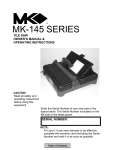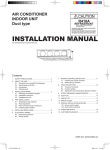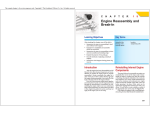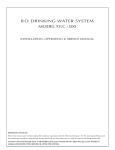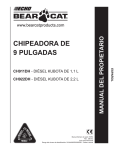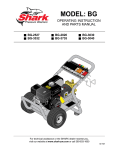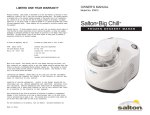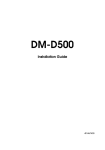Download MK BX-4 Owner`s manual
Transcript
BX-3 BRICK XTREME DRY BRICK SAW OWNER’S MANUAL & OPERATING INSTRUCTIONS CAUTION: Read all safety and operating instructions before using this equipment Enter the Serial Number of your new saw in the space below. The Serial Number is located on the left side of the blade guard. SERIAL NUMBER: NOTE: For your (1) one year warranty to be effective, complete the warranty card (including the Serial Number) and mail it in as soon as possible. Table of Contents INTRODUCTION and TABLE OF CONTENTS INTRODUCTION: We at MK Diamond want to congratulate you on selecting the BX-3 Dry Brick Saw. We are certain that you will be pleased with your purchase. MK Diamond takes pride in producing the finest products in the industry. Operated correctly, your BX-3 should provide you with years of quality service. In order to help you, we have included this manual. This owners manual contains information necessary to operate and maintain your BX-3 safely and correctly. Please take a few minutes to familiarize yourself with the BX-3 by reading and reviewing this manual. If you should have questions concerning your BX-3, please feel free to call our friendly customer service department at: 800 421-5830 TABLE OF CONTENTS Page SAFETY: Safety Messages Damage Prevention Message General Safety Precautions and Hazard Symbols California Proposition 65 Message Electrical Requirements and Grounding Instructions Safety Label Locations Brick Saw Specific Warnings Product Specifications 3 3 3 5 6 8 8 9 UNPACKING AND ASSEMBLY Unpacking Contents Transport Assembly 10 10 10 11 SETUP, ADJUSTMENT AND OPERATION Setup Adjustment and Operation Cleanup 12 14 17 MAINTENANCE AND TROUBLESHOOTING Maintenance Troubleshooting 18 24 EXPLODED VIEW AND PARTS LIST Exploded View Parts List 26 27 THEORY Theory of Diamond Blades 29 ACCESSORIES, ORDERING and RETURN INSTRUCTIONS Accessories Ordering Information Return Material Policy Packaging Instructions Authorized Service Centers 30 31 31 31 31 Manual Part No. 158168 BX-3 Revision 11/00, Effective Date November 1, 2000 Revision No. 2 Page 2 SAFETY Read and follow all safety, operating and maintenance instructions. Failure to read and follow these instructions could result in injury or death to you or others. Failure to read and follow these instructions could also result in damage and/or reduced equipment life. SAFETY MESSAGES: Safety messages inform the user about potential hazards that could lead to injury, death and/or equipment damage. Each safety message will be preceded by one of the following (3) three words that identify the severity of the message. Not following instructions WILL lead to DEATH or SERIOUS INJURY Not following instructions COULD lead to DEATH or SERIOUS INJURY Not following instructions CAN lead to injury DAMAGE PREVENTION AND INFORMATION MESSAGES: A Damage Prevention Message is to inform the user of important information and/or instructions that could lead to equipment or other property damage if not followed. Information Messages convey information that pertains to the equipment being used. Each message will be preceded by the word NOTE, as in the example below. NOTE: Equipment and/or property damage may result if these instructions are not followed. GENERAL SAFETY PRECAUTIONS AND HAZARD SYMBOLS: In order to prevent injury, the following safety precautions and symbols should be followed at all times! Safety Precautions: KEEP GUARDS IN PLACE. In order to prevent injury, keep guards in place and in working order at all times. REMOVE ADJUSTING KEYS AND WRENCHES. Form a habit of checking to see that keys and adjusting wrenches are removed from the power tool before it is turned on. KEEP WORK AREA CLEAN. Cluttered work areas and benches invite accidents. DO NOT USE IN DANGEROUS ENVIRONMENTS. Do not use power tools in damp or wet locations nor expose them to rain. Always keep the work area well lighted. KEEP CHILDREN AWAY. All visitors and children should be kept a safe distance from work area. MAKE THE WORKSHOP KID PROOF. Make the workshops kid proof by using padlocks, master switches or by removing starter keys. DO NOT FORCE THE TOOL. A power tool will do a job better and safer operating at the rate for which it was designed. USE THE RIGHT TOOL. Do not force a tool or an attachment, to do a job that it was not designed to do. BX-3 Revision 11/00, Effective Date November 1, 2000 Table of Contents Page 3 SAFETY USE THE PROPER EXTENSION CORD. If using an extension cord make sure it is in good condition first. When using an extension cord, be sure to use one heavy enough to carry the current your product will draw. An undersized cord will cause a drop in line voltage that will result in a loss of power and overheating. TABLE 1, Page 7 shows the correct AWG size to use depending on cord length and nameplate ampere rating. If in doubt, use the next heavier gage. The smaller the gage number, the heavier the cord. WEAR PROPER APPAREL. Do not wear loose clothing, gloves, neckties, rings, bracelets, or other jewelry that may be caught in moving parts. Non-slip footwear is recommended. Wear protective hair covering to contain long hair. ALWAYS USE SAFETY GLASSES. Safety glasses should always be worn when working around power tools. In addition, a face, dust mask or respirator should be worn if a cutting operation is dusty. Everyday eyeglasses only have impact resistant lenses and may not prevent eye injury-they are NOT safety glasses. SECURE WORK. Clamps or a vise should be used to hold work whenever practical. Keeping your hands free to operate a power tool is safer. DO NOT OVERREACH. Keep proper footing and balance at all times by not overreaching. MAINTAIN TOOLS WITH CARE. Keep tools clean for the best and safest performance. Always follow maintenance instructions for lubricating, and when changing accessories. DISCONNECT TOOLS. Power tools should always be disconnected before servicing or when changing accessories, such as blades, bits, cutters, and the like. REDUCE THE RISK OF UNINTENTIONAL STARTING. Make sure the trigger switch; locking button is in the RELEASE position before plugging in a power tool. USE RECOMMENDED ACCESSORIES. Consult the owner's manual for recommended accessories. Using improper accessories may increase the risk of personal or by-stander injury. NEVER STAND ON THE TOOL. Serious injury could occur if a power tool is tipped, or if a cutting tool is unintentionally contacted. CHECK FOR DAMAGED PARTS. Before using a power tool, check for damaged parts. A guard or any other part that is damaged should be carefully checked to determine it would operate properly and perform its intended function. Always check moving parts for proper alignment or binding. Check for broken parts and mountings and all other conditions that may affect the operation of the power tool. A guard, or any damaged part, should be properly repaired or replaced. DIRECTION OF FEED. Always feed work into a blade or cutter against the direction of rotation. A blade or cutter should always be installed such that rotation is in the direction of the arrow imprinted on the side of the blade or cutter. NEVER LEAVE A TOOL RUNNING UNATTENDED – TURN POWER OFF. Do not leave a tool until it comes to a complete stop. Always turn a power tool OFF when leaving the work area, or, when a cut is finished. BX-3 Revision 11/00, Effective Date November 1, 2000 Table of Contents Page 4 SAFETY Hazard Symbols: ELECTRICAL SHOCK! Never touch electrical wires or components while the motor is running. Exposed, frayed or worn electrical motor wiring can be sources of electrical shock that could cause severe injury or burns. ACCIDENTAL STARTS! Before plugging the equipment into an electrical outlet, be sure the trigger switch, locking button is in the "RELEASE" position to prevent accidental starting. Unplug the power tool before performing any service operation. ROTATING OR MOVING PARTS! Keep hands, feet, hair, and clothing away from all moving parts to prevent injury. Never operate a power tool with covers, shrouds, or guards removed. Sawing and drilling generates dust. Excessive airborne particles may cause irritation to eyes, skin and respiratory tract. To avoid breathing impairment, always employ dust controls and protection suitable to the material being sawed or drilled; See OSHA (29 CFR Part 1910.1200). Diamond Blades improperly used are dangerous. Comply with American National Standards Institute Safety Code, B7.1 and, Occupational Safety and Health Act covering Speed, Safety Guards, Flanges, Mounting Procedures, General Operating Rules, Handling, Storage and General Machine Conditions. CALIFORNIA PROPOSITION 65 MESSAGE: Some dust created by power sanding, sawing, grinding, drilling, and other construction activities contain chemicals known [to the State of California] to cause cancer, birth defects or other reproductive harm. Some examples of these chemicals are: • Lead, from lead-based paints • Crystalline silica, from bricks and cement and other masonry products and • Arsenic and chromium, from chemically treated lumber Your risk from these exposures varies depending on how often you do this type of work. To reduce your exposure to these chemicals, work in a well-ventilated area, and work with approved safety equipment, such as those dust masks that are specially designed to filter out microscopic particles. BX-3 Revision 11/00, Effective Date November 1, 2000 Table of Contents Page 5 SAFETY ELECTRICAL REQUIREMENTS AND GROUNDING INSTRUCTIONS: In order to prevent potential electrical shock and injury, the following electrical safety precautions and symbols should be followed at all times! In case of a malfunction or breakdown, grounding provides a path of least resistance for electric current to reduce the risk of electric shock. This tool is equipped with an electric cord having an equipment-grounding conductor and a grounding plug. The plug must be plugged into a matching outlet that is properly installed and grounded in accordance with all local codes and ordinances. • Do not modify the plug provided – if it will not fit the outlet; have the proper outlet installed by a qualified electrician • Improper connections of the equipment-grounding conductor can result in a risk of electric shock. The equipment-grounding conductor is the insulated conductor that has an outer surface that is green, with or without yellow stripes. If repair or replacement of the electric cord or plug is necessary, do not connect the equipment-grounding conductor to a live terminal • Check with a qualified electrician or service personnel if the grounding instructions are not completely understood, or if in doubt as to whether the tool is properly grounded • Use only 3-wire extension cords that have 3-prong grounding plugs and 3-pole receptacles that accept the tool's plug • Repair or replace a damaged or worn cord immediately Grounding Pin This tool is intended for use on a circuit that has an outlet that looks like the one shown in Sketch A of Figure 1. The tool has a grounding plug that looks like the plug illustrated in Sketch A of FIGURE 1. A temporary adapter, which looks like the adapter illustrated in sketches B and C, may be used to connect this plug to a 2-pole receptacle as shown in Sketch B, if a properly grounded outlet is not available. The temporary adapter should be used only until a properly grounded outlet can be Metal Screw installed by a qualified electrician. The green-colored rigid ear, CCover of Grounded Outlet Box lug, and the like, extending from the adapter, must be connected (A) (B) to a permanent ground such as a properly grounded outlet box. ADAPTER (C) Grounding Means Grounding Pin NOTE: Use of a temporary adapter is not permitted in Canada. (D) FIGURE 1 To reduce the risk of electrocution, keep all connections dry and off the ground. A Ground Fault Circuit Interrupter (GFCI) should be provided on the circuit(s) or outlet(s) to be used for the Brick Saw. Receptacles are available having built-in GFCI protections and may be used for this measure of safety. When using an extension cord, the GFCI should be installed closest to the power source, followed by the extension cord and lastly, the saw. BX-3 Revision 11/00, Effective Date November 1, 2000 Table of Contents Page 6 SAFETY Power Cord To avoid the possibly of the appliance plug or receptacle getting wet, position the Brick Saw to one side of a wall mounted receptacle. This will prevent water from dripping onto the receptacle or plug. A "drip loop," shown in FIGURE 2, should be arranged by the user to properly position the power cord relative to the power source. The "drip loop" is that part of the cord below the level of the receptacle, or Power Tool the connector, if an extension cord is used. This method of positioning the Supporting Surface cord prevents the travel of water along the power cord and coming in contact with the receptacle. If the plug or receptacle gets wet, DO NOT unplug the cord. Disconnect the fuse or circuit breaker that supplies power to the tool. Then unplug and examine for presence of water in the receptacle. Drip Loop FIGURE 2 Use only extensions cords that are intended for outdoor use. These extension cords are identified by a marking "Acceptable for use with outdoor appliances; store indoors while not in use." Use only extension cords having an electrical rating not less than the rating of the product. Do not use damaged extension cords. Examine extension cords before using and replace if damaged. Do not abuse extension cords and do not yank on any cord to disconnect. Keep cords away from heat and sharp edges. Always disconnect the extension cord from the receptacle before disconnection the product form the extension cord. Use of undersize extension cords result in low voltage to the motor that can result in motor burnout and premature failure. MK Diamond warns that equipment returned to us showing signs of being run in a low voltage condition, through the use of undersized extension cords will be repaired or replaced totally at the customers expense. There will be no warranty claim. To choose the proper extension cord, • Locate the length of extension cord needed in TABLE 1 below. • Once the proper length is found, move down the column to obtain the correct AWG size required for that length of extension cord. As an example, a fifty (50) foot extension cord would require an AWG size of 16. Extension Cord Minimum Gage for Length Volts 120V BX-3 25 ft. AWG 14 Total Length of Cord in Feet 50 ft. 100 ft 150 ft. AWG AWG AWG 12 Not Recommended TABLE 1 Revision 11/00, Effective Date November 1, 2000 Table of Contents Page 7 SAFETY SAFETY LABEL LOCATIONS: Safety labels are located according to Figures 1 to 4 below. The labels contain important safety information. Please read the information contained on each safety label. These labels are considered a permanent part of your saw. If a label comes off or becomes hard to read, contact MK Diamond or your dealer for a replacement Item 1. 2. 3. 4. Location Left Side, Upper Cross Member Right Side, Upper Cross Member Back, Upper Cross Member Blade Guard Description Caution Safety Label Dust Inhalation Warning Label Extension Cord Warning Label Serial Number and Motor Specifications 1 2 3 4 Part No. 155576 154337 155672 158096 BRICK SAW SPECIFIC WARNINGS: Ø Read Owners Manual Ø Wear Protective Gear for – BX-3 • • • • Head Lungs Ear Eye Revision 11/00, Effective Date November 1, 2000 Table of Contents Page 8 SAFETY PRODUCT SPECIFICATIONS: The BX-3 is a versatile lightweight, dry, masonry saw. Operated and used according to this manual, the BX-3 will provide years of dependable service. General Description: The BX-3, Brick Xtreme, is engineered as a 14" dry saw, consisting of a powerful 115v motor in a hard plastic case. The saw is capable of cutting brick and masonry up to 8" x 8" x 16" in size; the blade has a five (5) inch cutting depth. Motor and Weight Specifications: Motor and Weight specifications for the BX-3 are listed in Table 2 below. Voltage Amperage Frequency RPM Weight 115 v 13 A 60 Hz 3,500 rpm 45 lbs.* Table 2 Blade Capacity: The BX-3 uses a 14-inch diameter segmented dry MK Diamond blade with a .110-inch cutting width. Masonry Types: The BX-3 can cut a variety of masonry types including, cinder block, slump stone block, wall brick, paver brick, concrete block and cylinders, roofing tile, marble, granite, decorative rock or almost any other nonferrous material. NOTE: The BX-3 is not designed to cut plastic or ferrous (metals) material. Spring Assisted Cutting Head: The BX-3 is designed with a spring assisted Cutting Head to allow for easier step cutting. The Cutting Head can be locked in the down position when cutting smaller pieces. Lockable Trigger Switch: The BX-3 is designed with a lockable trigger-operating switch in the handle to allow for ease of operation. Removable Motor Air Filter: The BX-3 is designed with an easy clean motor air filter to extend the life of the motor. Replaceable Motor Brushes: The BX-3 is designed with replaceable motor brushes to extend operating life. *Without Movable Cutting Table BX-3 Revision 11/00, Effective Date November 1, 2000 Table of Contents Page 9 UNPACKING, TRANSPORT and ASSEMBLY UNPACKING: Your BX-3 has been shipped from the factory thoroughly inspected. Only minimal assembly is required. If not already done, remove the BX-3 from the carton and place it on a flat surface. Remove Strapping. Remove the Accessories box from the main carton and place along side the BX-3 (Owners Manual is in Accessories Box). CONTENTS: In the containers, you will find one (1) BX-3, one (1) 14 inch segmented dry diamond blade (or segmented block blade), one (1) movable cutting table, one (1) adjustable cutting guide, one replacement motor air filter, one (1) blade wrench, one (1) shaft wrench, one (1) owner's manual and one (1) warranty card. BX-3 Segmented Dry Diamond Blade Adjustable Cutting Guide Movable Cutting Table Shaft Wrench Owner's Manual Warranty Card Extra Motor Air Filter - OR - Blade Wrench TRANSPORT: The BX-3 weighs approximately forty (45) pounds (Without the Movable Cutting Table), making transport easy. Always observe safe lifting practices when lifting the BX-3. NOTE: Lock the Cutting Head in the DOWN position, and remove the Movable Cutting Table when transporting the BX-3. Due to its lightweight construction, the BX-3 is designed to be carried by the durable aluminum frame. Simply lock the spring assisted cutting head in the DOWN position, grasp the frame by the lower front and upper back cross members, lift and transport the BX-3 to the desired work location Locking Pin Inserted Lift Point Cutting Head Locked Down BX-3 Revision 11/00, Effective Date November 1, 2000 Table of Contents Page 10 UNPACKING, TRANSPORT and ASSEMBLY ASSEMBLY: Follow the assembly instructions to prepare your BX-3 for operation. 1. Movable Cutting Table Installation: Cutting Table Front Roller Wheels Ease of Movement (See Maintenance Section If Problems Arise) Guide Rails Guide Rail Roller Wheels (A) Position Movable Cutting Table (B) Seat Roller Wheels on Guide Rails (C) Verify Correct Seating 2. Adjustable Cutting Guide Installation: Turn to Loosen Align Parallel Slots Turn to Tighten Seated Ruler/Stop (A) Loosen Thumbscrew (B) Position Adjustable Cutting Guide (C) Seat and Tighten Adjustable Cutting Guide 3. Diamond Blade Installation: NOTE: When installing the Retaining Screw, do not “cross-thread" and DO NOT over tighten the screw. Motor Shaft Hold Shaft Wrench Stationary Outer Flange (B) Remove Retaining Screw and Outer Flange (A) Identify Retaining Screw and Outer Flange Hold Shaft Wrench Stationary Rotate Blade Wrench Counter-clockwise Retaining Screw Seat Blade on Inner Flange Rotation Direction (C) Install and Seat Blade – Verify Rotation Rotate Blade Wrench Clockwise (D) Install Retaining Screw and Outer Flange - Tighten BX-3 Revision 11/00, Effective Date November 1, 2000 Table of Contents Page 11 SETUP, ADJUSTMENT and OPERATION SETUP: • • • Before powering or starting, check for damage that could prevent this equipment from proper operation or performing its intended function. Check for binding and alignment of moving parts. Check for damaged, broken, or missing parts. Verify the trigger switch, locking button is in the "RELEASE" position. Before connecting the BX-3 to a power supply, be sure the voltage, cycle and phase of the job site power source meet the requirements of TABLE 3 VOLTAGE: CYCLE: PHASE: • • • 115v 60hz single phase TABLE 3 If using an extension power cord, make sure the length and wire gauge corresponds to the requirements listed in TABLE 1 on page 7. An extension power cord that is too small in wire gauge (diameter), or too long in length, will cause the motor to overheat and could cause premature failure. Use an approved Ground Fault Circuit Interrupter (GFCI) Do not cover the motor vents as this could lead to motor overheating. Portable Generator: If using a portable generator to provide power, ensure the generator meets the following minimum requirements: 8 kW 120/240 volts 66.7/33.3 amps Single Phase Pre-start Inspection: The pre-start inspection should be performed before beginning any job. NOTE: In order to avoid breaker tripping, a 20-amp circuit breaker should be used. If the Diamond Blade shows signs of fatigue cracking, replace the blade before starting work. Cracks Ease of Movement (See Maintenance Section if Problems Arise) Replace if Excessively Grooved (See Maintenance Section if Problems Arise) (A) Inspect Blade for Damage – Verify Blade Correct for Material Being Cut (B) Inspect Wooden Strip for Excessive Grooves Check for Cleanliness (See Maintenance Section) (C) Movable Cutting Table Moves Freely Trigger Lock (Push to Lock) Trigger Switch (Push to Unlock) Inspection Points Underside of Handle (D) Inspect for Damage BX-3 (E) Inspect Motor Air Filter for Cleanliness Revision 11/00, Effective Date November 1, 2000 Table of Contents (F) Verify Trigger Switch Unlocked Page 12 SETUP, ADJUSTMENT and OPERATION If an extension cord is used, first verify it meets the requirements of TABLE 1 (page 9). Plug the BX-3 into the extension cord; plug the extension cord into a GFCI. Finally, plug the GFCI into the power source in that order. GFCI (G) Plug GFCI into BX-3 BX-3 Power Source (H) Plug GFCI into Power Source Revision 11/00, Effective Date November 1, 2000 Table of Contents Page 13 SETUP, ADJUSTMENT and OPERATION ADJUSTMENT AND OPERATION: 1. Cutting Setup: Ruler/Stop Set Edge of Cutting Guide to Desired Cut Length on Ruler/Stop Ruler Markings (A) Set Adjustable Cutting Guide Set against Adjustable Cutting Guide and Ruler/Stop Adjustable Cutting Guide Ruler/Stop (B) Position Masonry Piece DO NOT FORCE the blade to cut, it will do the job better and safer at rate for which it was designed. 2. Step Cuts: A Step Cut is performed when a series of small cuts of increasing depth are used to complete a single cut. Step Cuts are used for large objects or for hard objects such as Firebrick and Pavers. NOTE: 1. Step Cutting is the preferred cutting method for all cuts. 2. When cutting hard material Step Cutting should always be used. 3. Step Cutting will extend the life of the Diamond Blade. Depress Trigger to Start (Lock if Desired) Hold Work in Position (A) Step Cut Setup Lower Cutting Head 1/4 -1/2 Inch During Push Stroke Lower Cutting Head Additional 1/4 -1/2 Inch During Pull Stroke Pull Direction Push Direction (B) Step Cut “Push” Stroke (C) Step Cut “Pull” Stroke Release Trigger Switch Repeat “Push” and “Pull” Strokes Until Cut Complete (D) Repeat Steps B and C Until Cut Complete BX-3 Raise Cutting Head Allow Blade to Stop Before Removing Work (E) Cutting Complete Revision 11/00, Effective Date November 1, 2000 Table of Contents Page 14 SETUP, ADJUSTMENT and OPERATION 3. Chop Cutting: A Chop Cut is performed by cutting completely through an object in one pass. Depress Trigger to Start (Lock if Desired) Hold Roller Trolley Stationery Lower Cutting Head Smoothly to Cut Continue to Lower Cutting Head until Cut Complete Position Work Below Cutting Head (B) Lower Cutting Head to Begin Cutting (A) Chop Cut Setup (C) Continue Lowering Head until Cut Complete Release Trigger Switch Raise Cutting Head Allow Blade to Stop Before Removing Work (D) Cutting Complete 4. Cutting with the Cutting Head Locked Down: This method is preferred when cutting small objects. Lock Trigger Switch Align Holes and Lock Cutting Head in Position (A) Lock Cutting Head in the Down Position Unlock Trigger Switch When Cut Complete (B) Locked Cutting Head Setup Push Slowly to Cut (C) Slowly Push Piece toward Blade to Begin the Cut Allow Blade to Stop Before Removing Work Remove Locking Pin to Release Cutting Head Continue to Push until Cut Complete (D) Continue Pushing Piece into Blade until Cut Complete BX-3 Hold Work in Position Push Slowly to Cut Hold in Position (E) Cutting Complete Revision 11/00, Effective Date November 1, 2000 Table of Contents Page 15 SETUP, ADJUSTMENT and OPERATION 5. Angle Cuts: Angle Cuts may be performed using the Step Cut, Chop Cut or the Locked Cutting Head cutting methods. The following is utilizing the Locked Cutting Head method. Turn to Loosen Remove Adjustable Cutting Guide Adjustable Cutting Guide Ruler/Stop (A) Remove Adjustable Cutting Guide Set against Adjustable Cutting Guide and Ruler/Stop Align 45° Slots to Ruler/Stop (B) Reposition Adjustable Cutting Guide Ruler/Stop (C) Position Adjustable Cutting Guide DO NOT FORCE TOOL, it will do the job better and safer at the rate for which it was designed. Lock Trigger Switch Align Holes and Lock Cutting Head in Position (E) Locked Cutting Head Setup (D) Lock Cutting Head in the Down Position Unlock Trigger Switch when Cut Complete (G) Continue Pushing Piece into Blade until Cut Complete Push Slowly to Cut (F) Slowly Push Piece toward Blade to Begin the Cut Unlock Trigger Switch when Cut Complete Allow Blade to Stop Before Removing Work Continue to Push until Cut Complete BX-3 Hold Work in Position (H) Cutting Complete Revision 11/00, Effective Date November 1, 2000 Table of Contents Remove Locking Pin to Release Cutting Head Hold in Position (I) Release Cutting Head Page 16 SETUP, ADJUSTMENT and OPERATION 6. Cleanup: Power Source GFCI (A) Unplug GFCI from Power Source (B) Unplug GFCI from BX-3 Pull Straight Back To Remove Cap (C) Remove Motor Filter Cap Always wear eye protection when using compressed air. Pull Foam Filter Out of Filter Cap Install Foam Filter into Filter Cap Tap on Hard Surface to Dislodge Dirt (D) Remove Filter from Filter Cap Push Filter Cap onto Spacer Pins to seat Align Filter Cap Retaining Clips to Spacer Pins (G) Install Motor Filter Cap onto Motor BX-3 (E) Clean Filter by Tapping on Hard Surface or using Compressed Air (F) Reinstall Filter into Filter Cap Clean Roller Wheels Clean Guide Rails (H) Clean the Movable Cutting Table Roller Wheels and Guide Rails Revision 11/00, Effective Date November 1, 2000 Table of Contents Clean BX-3 Using Clean Cloth (I) Clean Remainder of BX-3 Page 17 MAINTENANCE AND TROUBLESHOOTING MAINTENANCE: 1. General Maintenance: The following maintenance should be performed following each use. Use Light oil, such as WD-40 or 3 in 1 when lubricating parts. Lubricate Torsion Spring Lubricate Roller Wheels Lubricate Guide Rails (A) Lubricate Cutting Head Torsion Spring (B) Lubricate Movable Cutting Table Roller Wheels and Guide Rails 2. Monthly Maintenance: The following should be performed monthly. Items should be lubricated as directed. Clean and Lubricate Inspect for Wear Clean and Lubricate (A) Clean and Lubricate Inner Flange and Motor Shaft BX-3 (B) Clean and Lubricate Blade Retaining Screw Revision 11/00, Effective Date November 1, 2000 Table of Contents (C) Check Roller Wheels and Guide Rails for Wear Page 18 MAINTENANCE AND TROUBLESHOOTING 3. Blade Dressing: Like most cutting instruments, a diamond blade performs best when it is dressed. Over time and use, diamonds on the outer edge will become smooth or “glazed” over. This will reduce grinding efficiency and may cause the blade to “wander” or bend, giving the illusion of an alignment problem. When this occurs, the blade will need to be dressed. The diamond blade can be dressed using the MK Dressing Stick (part number 152792) and by following the steps below. Ruler/Stop Set up for Operation (See Setup, Adjustment and Operation) (A) Set BX-3 for Operation Set Edge of Cutting Guide to Desired Cut Length on Ruler/Stop Ruler Markings (B) Set Adjustable Cutting Guide to Cut 1/16-inch Strips Set against Adjustable Cutting Guide and Ruler/Stop Adjustable Cutting Guide Ruler/Stop (C) Position Dressing Stick DON'T FORCE TOOL, it will do the job better and safer at the rate for which it was designed. Depress Trigger to Start (Lock if Desired) Hold Dressing Stick in Position (D) Set up for Blade Dressing Lower Cutting Head while Pushing Dressing Stick into Blade Repeat Cut Stroke 8-times Push Direction (E) Begin Blade Dressing (F) Repeat Cut Stroke to Dress Blade Release Trigger Switch Raise Cutting Head Allow Blade to Stop Before Removing Dressing Stick (G) Dressing Complete BX-3 Revision 11/00, Effective Date November 1, 2000 Table of Contents Page 19 MAINTENANCE AND TROUBLESHOOTING 4. Diamond Blade Change-out: Disconnect the tool before servicing and when changing accessories, such as blades, bits, cutters, and the like. Hold Shaft Wrench Stationary Set up for Operation (See Setup, Adjustment and Operation) Retaining Screw Remove Blade Rotate Blade Wrench Counter-clockwise (A) Setup BX-3 for Operation (B) Remove Retaining Screw and Outer Flange (C) Remove Blade from Motor Shaft NOTE: When installing the Retaining Screw, do not “cross-thread" and DO NOT over tighten the screw. Seat Blade on Inner Flange Hold Shaft Wrench Stationary Rotate Blade Wrench Clockwise Rotation Direction (D) Install Blade Under Blade Guard and Onto Motor Shaft BX-3 (E) Install Outer Flange and Retaining Screw – Tighten Revision 11/00, Effective Date November 1, 2000 Table of Contents Page 20 MAINTENANCE AND TROUBLESHOOTING 5. Movable Cutting Table Wheel Change Out: NOTE: All four (4) Movable Cutting Table, Roller Wheels should be replaced at the same time (MK Diamond Part No. – 133090). Rotate Wrench Counter-clockwise 1/2-Inch Wrench Roller Wheels Clean Holes (B) Remove Roller Wheels (A) Place Movable Cutting Table On Work Bench with Roller Wheels Up (C) Prepare for Installation Of New Roller Wheels NOTE: When installing the Retaining Bolt, do not “cross-thread" and DO NOT over tighten the Nut. Washer Rotate Wrench Counter-clockwise Roller Wheel (D) Install Wheel/Washer Assembly Into Movable Cutting Table 1/2-Inch Wrench (E) Install Roller Wheel Retaining Nut – Tighten Lubricate with Light Oil (WD-40, 3 in 1, etc) (F) Lubricate Roller Wheels Install Movable Cutting Table (See Setup, Adjustment and Operation (G) Install Movable Cutting Table BX-3 Revision 11/00, Effective Date November 1, 2000 Table of Contents Page 21 MAINTENANCE AND TROUBLESHOOTING 6. Protective Wooden Strip Replacement: The protective wooden strip is to protect the Movable Cutting Table from damage during operation. Over time, the wooden strip will become grooved from use. A grooved wooden strip will not support masonry during cutting, causing the blade to "break through" the piece instead of performing a smooth cut (MK Diamond Part No. – 156427). Phillips Screwdriver Roller Wheels Retaining Screw (A) Place Movable Cutting Table on Work Bench – Wheels Up with Roller Wheels Up (B) Remove the Two Protective Wooden Strip Retaining Screws Phillips Screwdriver Worn Wooden Strip New Wooden Strip (C) Place Movable Cutting Table on Work Bench – Wheels Down Install Movable Cutting Table (See Setup, Adjustment and Operation Retaining Screw (D) Replace Worn Protective Wooden Strip BX-3 Protective Wooden Strip (E) Place Movable Cutting Table on Work Bench – Wheels Up, Reinstall Retaining Screws Revision 11/00, Effective Date November 1, 2000 Table of Contents (F) Install Movable Cutting Table Page 22 MAINTENANCE AND TROUBLESHOOTING 7. Motor Brush Change-out: Disconnect the tool before servicing and when changing accessories, such as blades, bits, cutters, and the like. Disconnect BX-3 Clean Brush Housing of Carbon All Carbon Dust and Fragments Phillips Screwdriver (A) Disconnect the BX-3 Remove Motor Brush One Cap on Rotate Screw Driver Either Side of Motor Counter-clockwise (B) Locate and Remove One Motor Brush Cap (C) Remove Motor Brush and Clean Brush Housing NOTE: When installing motor brushes, care must be taken to ensure the spring end is straight before installing the Motor Brush Cap. Align Motor Brush with Brush Housing and Install the Brush Rotate Screw Driver Clockwise Replace Second Motor Brush Phillips Screwdriver (D) Align and Install New Motor Brush BX-3 (E) Install Motor Brush Cap Revision 11/00, Effective Date November 1, 2000 Table of Contents (F) Install the Second Motor Brush (Repeat Steps B to E) Page 23 MAINTENANCE AND TROUBLESHOOTING TROUBLESHOOTING: Verify the Lockable Switch is unlocked and the saw is disconnected from the power source before performing any troubleshooting procedure. 1. Motor Stops Turning: Verify Connected If GFCI Tripped, Reset and Restart BX-3 once If GFCI not Tripped, go to Step C (A) Verify all Plugs Fully Connected If Connected, go to Step B If not Tripped, go to Step E If Breaker Tripped, Reset once Attempt Restart (D) Verify Circuit Breaker Not Tripped (B) Check Ground Fault Circuit Interrupter (GFCI) Tripped If Circuit is 115 Volts, go to Step F If Circuit is not115 Volts, Change Circuit (E) Verify Source Voltage is 115 Volts If Less than 20 Amps, Switch to 20 Amp Breaker If 20 Amp Or Greater, go to Step D (C) Verify Circuit Breaker is 20 Amp or Greater Return to MK Diamond for Repair (F) Return to MK Diamond 2. Blade Will Not Cut Properly: If “Glazed,” Dress (See Blade Dressing) If not “Glazed, go to Step B If Rotation Not Correct, Reposition Blade If Rotation Correct, go to Step C If Core Bent, Change Blade (A) Check for Smoothness or “Glazing” (B) Check for Proper Rotation If Core Not Bent, go to Step D (C) Ensure Blade Core Not Bent Contact Place of Purchase or MK Diamond (800 421-5830) To Verify Blade If Blade Correct, go to Step E (D) Verify Blade Correct for Material Being Used BX-3 Return to MK Diamond for Repair (E) Return to MK Diamond Revision 11/00, Effective Date November 1, 2000 Table of Contents Page 24 MAINTENANCE AND TROUBLESHOOTING 3. Movable Cutting Table Does Not Move Correctly: If Dirty, Clean Rails If Clean, go to Step B (A) Check Guide Rails Clean If Damaged Replace If Not Damaged, go to Step C (B) Check for Roller Wheel Damage If Binding Present, Return to MK Diamond If No Binding, go to Step D (C) Verify Ease and Freedom of Movement Return to MK Diamond for Repair (D) Return to MK Diamond BX-3 Revision 11/00, Effective Date November 1, 2000 Table of Contents Page 25 EXPLODED VIEW AND PARTS LIST EXPLODED VIEW: BX-3 Revision 11/00, Effective Date November 1, 2000 Table of Contents Page 26 EXPLODED VIEW AND PARTS LIST PARTS LIST: Item A A1 A2 A3 A4 A5 A6 A7 A8 A9 A10 A11 A12 A13 A14 A15 A16 A17 B B1 B2 B3 C C1 C2 C3 C4 C5 C6 C7 C8 C9 C10 D D1 D2 D3 D4 D5 D6 D7 D8 D9 D10 D11 D12 D13 E E1 E2 BX-3 Description Assembly, Frame, Right Casting, Frame, Right Casting, Frame, Left Support, Horizontal Frame Tube Connector, ¼-20 Screw, ¼-20 x 1 ½ Hex Head Cap Washer, ¼ SAE Flat Washer, ¼ Split Lock Strap, Table Guide Rail Screw, ¼-20 x ¾, Hex Head Cap Washer, ¼ Split Lock Drive Stud, Round Head Grooved #16 (¼) x ½ Label, Adhesive “BX3” Label, Safety Caution Label, MK USA Tag, Serial, Brick Saw Label, Prop 65 Label, Warning, Extension Cord Assembly, Arm, Motor Mount Casting, Arm, Motor Mount Bushing, Nylon Flange Label, Adhesive “Brick Xtreme” Assembly, Pivot Clamp Casting, Pivot Clamp Screw, ¼-20 x 1 ¼ Socket Hd. Cap Washer, ¼ Split Lock Pin, Pivot ∅.625 x 5.6 Screw, Set ¼-20 x ¼ Cup Point Spring, Torsion Stop Block Screw, ¼-20 x 5/8, Socket Hd Cap Pin, Detent w/ Pull Ring Lanyard Assembly, Handle & Switch Handle, Upper Handle, Lower Screw, M3.5 x 12mm Screw, ¼-20 x ¾, Socket Hd. Cap Washer, ¼ SAE, Flat Washer, ¼ Split Lock Insert, Expansion, ¼-20 Standard Switch, Trigger Plate, Screw, Switch Mounting Cord, AC Power 120V Cover, Wire Screw, # 6-32 x 1 ¼, Socket Flat Head Washer, #6 Flat SAE Assembly, Motor Motor, AC 115 Volt / 13 Amp, 3500 RPM Flange, Outer Revision 11/00, Effective Date November 1, 2000 Table of Contents Qty 1 1 1 3 6 6 6 6 2 10 10 2 1 1 1 1 1 1 1 1 2 1 1 1 2 2 1 1 1 1 1 1 1 1 1 1 8 2 2 2 2 1 1 1 1 1 5 1 1 1 MK p/n n/a 157367 157369 157384 157930 151914 151915 152591 157383 152370 152591 158071 157959 155576 154334 158096 154337 155672 n/a 157599 157932 157958 n/a 157593 154683 152591 157645 157528 157702 158226 152587 157933 158072 n/a 157874 157875 158156 152587 151915 152591 158147 157934 157876 157935 157880 158160 158231 n/a 157801 158105 Page 27 EXPLODED VIEW AND PARTS LIST Item E3 E4 E6 E7 E8 E9 E10 E11 E12 F F1 F2 F3 F4 F5 F6 F7 F8 F10 F11 F12 H H5 H6 H7 H8 H8-A BX-3 Description Flange, Inner Screw, M10 – 1.5 x 20mm Hex Flange Screw, M6-1 x 20mm Hex Head Cap Washer, M6 Split Lock Cap, Motor Cap, Motor Filter Spacer Pin, Cap Screw Filter Element Screw, #6 x 1 ½, Combo Head Pan, Tapping Assembly, Table Casting, Table Stop, Rule Screw, ¼-20 x ¾ Hex Head Cap Nut, ¼-20, Hex w/ External Tooth Washer Wheel, Roller Nut, 5/16-18, Hex w/ External Tooth Washer Wood Strip, Table Insert Screw, #8 x 1 Pan Head Phil. Casting, Squaring Arm Screw, 5/16-18 x 1 ½, Thumb Nut, 5/16-18 Square Assembly, Accessory Pack Wrench, Blade Nut Wrench, Shaft Extra Filter Element Blade, MK-BX10, Dry Cutting 14”, Segmented Blade, MK-BX30, Dry Cutting 14”, Segmented Block Owner's Manual Revision 11/00, Effective Date November 1, 2000 Table of Contents Qty 1 1 4 4 1 1 2 1 2 1 1 1 4 4 4 4 1 2 1 1 1 1 1 1 1 1 1 1 MK p/n 158106 158107 158158 158159 157877 157878 157879 157729 158157 n/a 158144 134387 152370 153941 133090 151051 156427 151047 231276 151155 151156 n/a 158109 158110 157729 157957 157944 158168 Page 28 THEORY THEORY OF DIAMOND BLADES: Diamond blades do not really cut; they grind the material through friction. Diamond crystals, often visible at the leading edge and sides of the rim/segment, remove material by scratching out particles of hard, dense materials, or by knocking out larger particles of loosely bonded abrasive material. This process eventually cracks or fractures the diamond particle, breaking it down into smaller pieces. As a result, a diamond blade for cutting soft, abrasive material must have a hard metal matrix composition to resist this erosion long enough for the exposed diamonds to be properly utilized. Conversely, a blade for cutting a hard, nonabrasive material must have a soft bond to ensure that it will erode and expose the diamonds embedded in the matrix. These simple principles are the foundation of “controlled bond erosion”. Types of Cutting: There are two basic types of cutting-Dry or Wet. The choice of which type of blade to use depends on: • The requirements of the job • The machine/tool utilizing the diamond blade • The preference of the operator In the case of DRY cutting, the overwhelming popularity and quantity of hand-held saws and the flexible nature of MK Diamond blades to professionally handle most ceramic, masonry, stone and concrete materials, make the DRY cutting blade a very attractive tool. When using a DRY blade, the user must be aware of distinct operating practices to ensure optimum performance. DRY cutting blades require sufficient airflow about the blade to prevent overheating of the steel core. This is best accomplished by shallow, intermittent cuts of the material with periods of “free-spinning” (for several seconds) between each cut, to maximize the cooling process. For WET cutting applications, MK has the exact blade to compliment both the material to be cut and the wet cutting machine to be used. During cutting operations, liberal amounts of water act as a coolant to support the cutting effectiveness and longevity of the WET blade. Additionally, using water adds to the overall safety of cutting operations by keeping the dust signature down. Know All You Can About the Material You Wish to Cut BX-3 Revision 11/00, Effective Date November 1, 2000 Table of Contents Page 29 ACCESSORIES, ORDERING and RETURN INFORMATION ACCESSORIES: ITEM 1. NUMBER DESCRIPTION 157957 MK-BX10, Dry Cutting 14" Segmented Blade 157944 MK-BX30, Dry Cutting 14" Segmented Block Blade 231276 Adjustable Cutting Guide 133090 Roller Wheel 156427 Protective Wooden Strip 157729 Motor Air Filter 152610 Ground Fault Circuit Interrupter 2. 3. 4. 5. 6. 7. BX-3 Revision 11/00, Effective Date November 1, 2000 Table of Contents Page 30 ACCESSORIES, ORDERING and RETURN INFORMATION ORDERING INFORMATION: You may order MK Diamond products through your local MK Diamond distributor or, you may order direct from MK Diamond. NOTE: There is a $25.00 minimum order when ordering direct from MK Diamond. All purchases must be made using VISA or MasterCard. When ordering direct from MK Diamond, please have the following information ready before calling: • The Model Number of the saw • The Serial Number of the saw • Where the saw was purchased and when • The Part Number for the part(s) being ordered • The Part Description for the part(s) being ordered All parts may be ordered by calling toll free to – 800 421-5830 or 310 539-5221 and asking for Customer Service. For technical questions, call – 800 474-5594. RETURN MATERIALS POLICY: To expedite the service relative to the return of a product purchased through MK Diamond, please observe the following: NOTE: When returning all items, they must have been purchased within the previous twelve (12) months. • Have the Model Number of the saw • Have the Serial Number of the saw • Have the location of where the saw was purchased • Have the date when the saw was purchased • Contact Customer Service for approval to return the item(s) • Obtain a Returned Goods Number (RGA) authorizing the return • Follow the packaging instructions in the following section • Ensure your item(s) are prepaid to the destination For returned items, call toll free to – 800 421-5830 or 310 539-5221 and ask for Customer Service. For technical questions, call – 800 474-5594 or 310 257-2845. PACKAGING INSTRUCTIONS: • • • • • Remove the Blade guard and Support Angle Assembly Dry the saw before shipping When packing, include the following: BX-3, Diamond Blade, Blade guard and Support Angle Assembly and Adjustable Cutting Guide (Other Accessories are not required) Package the unit in its original container or one of comparable size (do not ship the unit partially exposed) Ensure all parts are secured in the packaging to prevent moving AUTHORIZED SERVICE CENTERS: For quicker repair time, you may contact MK Diamond Customer Service, toll free, at – 800 421-5830 or 310 539-5221 for the Authorized Service Center closest too you. For technical questions, call – 800 474-5594. BX-3 Revision 11/00, Effective Date November 1, 2000 Table of Contents Page 31 BX-3 BRICK XTREME BRICK SAW OWNER’S MANUAL & OPERATING INSTRUCTIONS CALIFORNIA PROPOSITION 65 MESSAGE: Some dust created by power sanding, sawing, grinding, drilling, and other construction activities contain chemicals known [to the State of California] to cause cancer, birth defects or other reproductive harm. Some examples of these chemicals are: • Lead, from lead-based paints • Crystalline silica, from bricks and cement and other masonry products and • Arsenic and chromium, from chemically treated lumber Your risk from these exposures varies depending on how often you do this type of work. To reduce your exposure to these chemicals, work in a well-ventilated area, and work with approved safety equipment, such as those dust masks that are specially designed to filter out microscopic particles. MK DIAMOND PRODUCTS, INC 1315 STORM PARKWAY, TORRANCE, CA 90509-2803 310 539 5158 Table of Contents
































